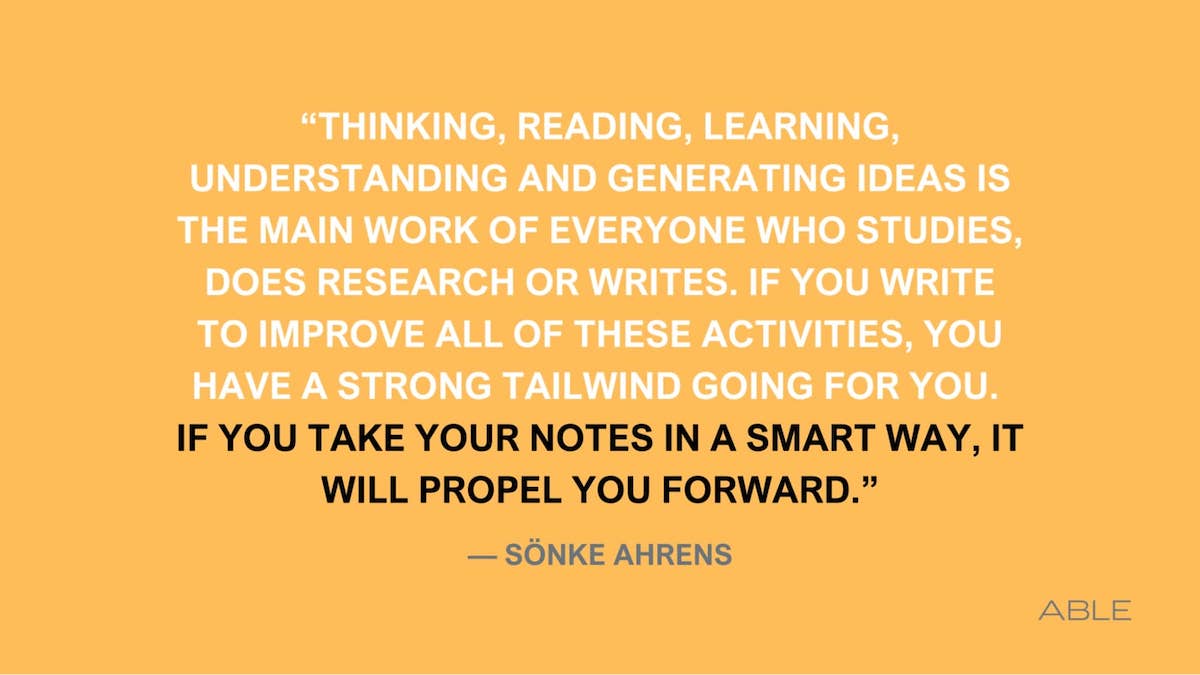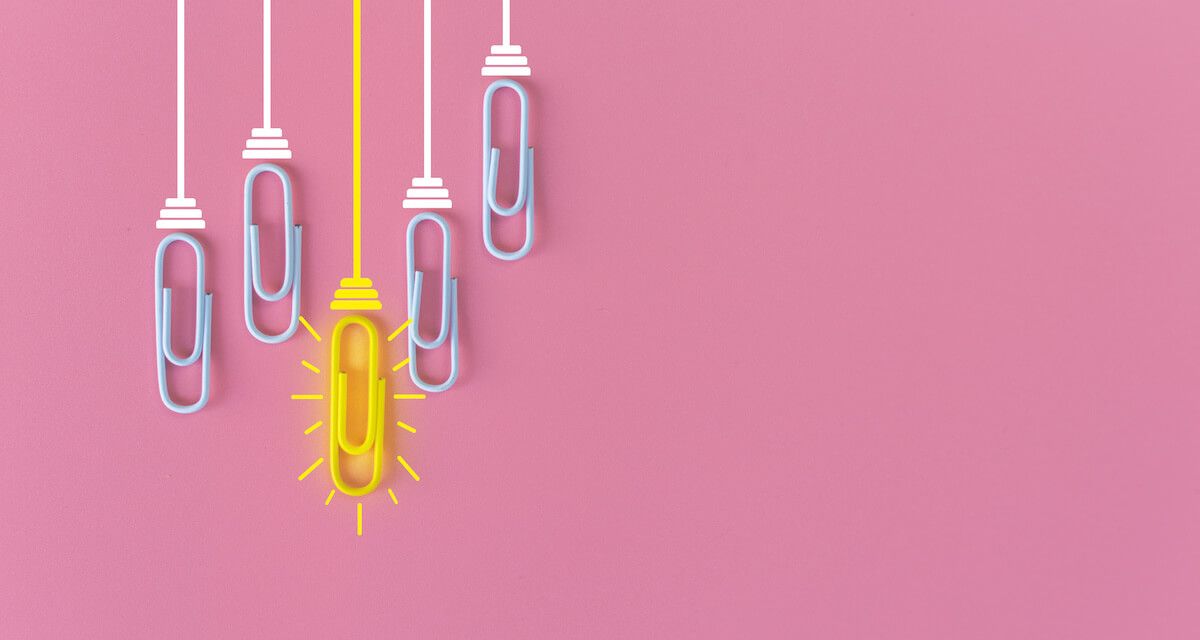Everyone writes. Whether you're a student composing a paper for an assignment or a professional writing a report for work, putting thoughts into words is a necessary part of communication.
In the age of information overload, it isn't enough to just write — you need to write smart. We face an endless stream of information every day, and it can be challenging to synthesize it into something meaningful.
Enter Sönke Ahrens and his book "How to Take Smart Notes: One Simple Technique to Boost Your Writing, Learning, and Creativity." Ahrens' note-taking system makes capturing and organizing your thoughts and knowledge easier, so you can write, learn, and create more effectively.
Whether you have trouble organizing information for writing or productivity, learning how to take smart notes can help.

The smart notes method is a note-taking system created by German author and educator Sönke Ahrens. In addition to teaching Philosophy of Education at the University of Duisburg-Essen, Ahrens coaches students, academics, and professionals on time management, decision-making, and personal development.
Ahrens’ book, "How to Take Smart Notes," was published in 2017 and has since been translated into at least eight languages. In 2022, it was updated to a second edition.
The book explains Ahrens' note-taking method, which helps people take more accessible and useful notes for writing, learning, and creativity. The book was initially intended for nonfiction writers, students, and academics, but it quickly became much more popular than expected.
The book focuses on writing, but as Ahrens points out, note-taking skills are helpful for anyone who wants to improve their thinking and learning skills.
"How to Take Smart Notes" is divided into three sections, each discussing the method from a different angle.
In the first section, Ahrens lays out the basic principles of the system and how it can be used for writing, learning, and creativity. He offers an overview of Niklas Luhmann's Zettelkasten system and how he adapted it for everyday use. He also outlines the benefits of taking smart notes and how the system can help you become more productive.
The second section lays out the research behind why the smart notes method works. Ahrens draws on psychological research to provide a scientific basis for the system, explaining the four underlying principles of the technique.
The final part of the book offers Ahren's tips for successful writing. Rather than giving step-by-step how-to's, Ahrens focuses on the cognition and psychology of writing. He likens the writing process to a primary mode of thinking and offers advice on a non-linear writing process that values generating insight.

The smart notes method is based on the principles of German sociologist Niklas Luhmann, who developed a system of notecards inside a "slip box" (or zettelkasten in German).
Luhmann's Zettelkasten was a system of index cards used to organize his thoughts and ideas. He wrote down his thoughts on individual index cards (or zettel), which he then filed away in boxes based on the topic. By cross-referencing and linking his zettel together, Luhmann was able to easily access and utilize his personal knowledge base when writing or thinking. Whenever he wanted to access a particular thought or idea, Luhmann simply looked in the relevant box.
Adapting Luhmann's notes for everyday use, Ahrens suggests that paper is fine for temporary notes but digital notes are the preferred method for permanent notes. This helps form a personal knowledge management system that is easier to search, organize, and locate.
In "How to Take Smart Notes," Ahrens details the cognition and learning research that forms the system's basis. This comes together to create the four underlying principles of the smart notes method.
Writing down new ideas is the best way to learn and understand them. Writing things down is a crucial step in the learning process. Summarizing, explaining, or describing an idea in your own words is critical to understanding it.
When you jot down notes throughout the day, your brain is freed up to focus on thinking and learning instead of remembering. However, keeping it simple is the key. With a standard format, notes can build up critical mass in one place, making it easier to access and process.
There’s a problem with how we are taught to write. Rather than brainstorming, which relies too heavily on the limitations of the brain, it’s best to let curiosity lead you to questions and topics. Taking smart notes allows you to create a slip box full of creative ideas.
By writing notes while reading, you’re forced to reflect, apply critical thinking strategies, and put what you read into your own words. As a result, you can improve your ability to understand and express yourself.

Gather information, take notes, review, reflect, surface insights. All from one perfect, distraction-free interface.
Learn more
Learning how to take smart notes may seem overwhelming at first. But it’s possible to adopt Ahrens' note-taking technique with these five simple steps.
Research estimates that we think 6,000 thoughts every day. With so many thoughts in our minds, it’s easy for a good idea to slip away if it isn't written down right away. That's why Ahren's "fleeting notes" are so important — they allow you to capture your ideas quickly so you can use them later.
Write down interesting pieces of information as you encounter them. A quick note can capture anything from a great conversation at dinner to a last-minute gift suggestion. To make a fleeting note, you only need a pen and paper. This can be a blank page in a journal or even a napkin in a pinch.
The key is to make your fleeting notes as brief and concise as possible — just enough to jog your memory later. These temporary notes only serve as stepping stones toward making permanent notes. Since they don't need to stand alone, you can be less concerned with perfection and just worry about getting the idea down. When you have some free time, you can develop an elaboration of the idea further.
Then, put the new notes in an inbox that you can process later. Remember that your understanding of your notes will be based on the context you took them from, so don't forget to review them promptly before you forget.
Fleeting notes are great for jotting down ideas when you're on the go, but you'll need more structure when reading. Literature notes are notes you take when you read, watch, or listen to something interesting. These are ideas you want to remember or explore further.
Literature notes are useful for pieces of information you read or data you collect for research projects. The more complicated the work or the less familiar you are with the topic, the more literature notes you will take.
According to Ahrens, literature notes should follow these guidelines:
Although literature notes are more detailed than fleeting notes, they aren't permanent, so don't worry about making them perfect. Also, don't feel like you should record everything. Just jot down the things you relate to or find interesting, along with their source.
As with fleeting notes, you should write everything down quickly and store it in your inbox. You'll turn these into permanent notes later.
After you've gathered your fleeting and literature notes, Ahrens recommends reviewing your inbox regularly (ideally once a day). You'll then decide which information to keep and which to discard.
When reviewing your notes, remember that this is not about gathering ideas. Connections for ideas, arguments, and discussions are the goal. Think about what is relevant to your self-learning goals and what's already inside your slip box. Keeping notes that contradict, correct, support, or add to your existing notes is a good idea.
You'll create a permanent note when you find something you'd like to keep. Your permanent notes are the final versions, written in your own words and full sentences, that you put in your slip box along with a citation. They should be self-contained and understandable.
When you’re ready to save a permanent note, you must file it in your slip box. You can use any tool, either a physical box or a digital method. Ahrens suggests that as long as the principles of Zettelkasten are well understood, they can be implemented with a wide range of tools, both analog and digital.
Many note-taking apps exist that can serve as digital slip boxes, such as Evernote and Notion. But because changing tools midway is always a hassle, it’s worth giving the right tool a bit of thought. On his website, Ahrens mentions standalone Zettelkasten programs, including Zettlr and The Archive.
However, many new tools have been developed with the specific purpose of building a knowledge management system and have had incredible responses. Apps like Roam Research and Obsidian are powerful and popular. Ahrens also recommends a separate reference tool like Zotero to help manage references.
In the end, it's not the tool but the system that counts, so keep the essentials in mind. "Good tools," Ahrens says, "do not add features and more options to what we already have but help to reduce distractions from the main work, which here is thinking."
Regardless of the tool you use, the best way to organize your notes is to use a specific filing system consistently. Filing by category is one of the most effective methods. For example, you could have a section for work notes, personal notes, school notes, etc. When you file a note in your slip box, simply place the new note in the appropriate category and label it with the date and any links to related notes within your system.
Keeping your slip box organized is a crucial part of the Zettelkasten method as it’ll make it easier for you to find information.

After creating your slip box of notes, start using it to generate new ideas. Your ideation method will depend on your preference, but one of the best ways to start is by identifying themes or patterns.
Look over your notes and see if any patterns emerge. Do you see any related notes, or does a group of existing notes have a common theme? By identifying these patterns, you can connect different ideas together and generate new questions to answer and topics to explore.
You can also scan through your notes for inspiration if you're struggling with an idea or stuck on a problem. Chances are, you've already done some of the hard work. All you need to do is put relevant notes together.
In addition, don't forget to share your insights with others. If you have a new idea or make a new connection, share it. Sharing your thoughts will give you feedback and input, and perhaps you'll inspire someone else to try the note-taking system.

Gather information, take notes, review, reflect, surface insights. All from one perfect, distraction-free interface.
Learn moreTaking smart notes is a simple but effective note-taking strategy that can boost your productivity, increase your creativity, and accelerate your learning. These steps will help you quickly get started using this powerful personal knowledge management system. The more practice you put into it, the more proficient you'll become at taking smart notes.
And remember, as Ahrens says, “Keep it light, do what feels right, adjust the workflow along the way. Try out different paths, experiment, be playful. There is no right and wrong as long as you stick to the principles. And don’t take it too seriously. Good ideas flourish in a relaxed environment.”
I hope you have enjoyed reading this article. Feel free to share, recommend and connect 🙏
Connect with me on Twitter 👉 https://twitter.com/iamborisv
And follow Able's journey on Twitter: https://twitter.com/meet_able
And subscribe to our newsletter to read more valuable articles before it gets published on our blog.
Now we're building a Discord community of like-minded people, and we would be honoured and delighted to see you there.